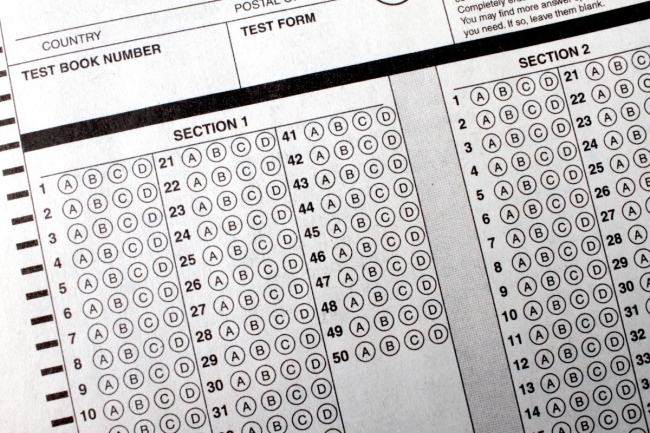You have /5 articles left.
Sign up for a free account or log in.

Radila Radilova/iStock/Getty Images Plus/Getty Images
The pandemic has spurred more community colleges to experiment with additional measures for determining placement into college-level math and English courses other than a single standardized placement test score, according to a new brief from researchers at the Center for the Analysis of Postsecondary Readiness (CAPR), a joint research center operated by the Community College Research Center (CCRC) at Teachers College, Columbia University, and MDRC, an education and social policy research organization.
The brief looks at how four states -- Indiana, Texas, Virginia and Washington -- developed alternative measures for determining student placement into first-year math and English courses after the pandemic made in-person, proctored exams harder to administer.
“The research has been around for a while showing the limitations of a single placement instrument,” said Susan Bickerstaff, the lead author of the brief and senior research associate and program lead at CCRC.
"This was an example where the pandemic actually accelerated reform work in many places because you could no longer administer in-person assessment," Bickerstaff said. "It’s an interesting case of COVID propelling the work forward when many other reform initiatives might have slowed down because people don’t have the time or bandwidth to move forward."
The brief, based on interviews with system leaders, college administrators, faculty and staff, looks at four different approaches for how states and institutions have scaled up the use of “multiple measures assessment” that incorporates more than one measure beyond a standardized placement test score to make decisions on placing students in developmental or college-level courses.
The first case study involves Ivy Tech Community College in Indiana, which rapidly scaled up its use of a low-stakes, adaptive assessment, called EdReady, across its 45 campuses statewide. According to the brief, Ivy Tech students “are offered the option to take the knowledge assessment in a non-proctored, self-paced environment” and are allowed “multiple attempts to modify their placement through the assessment, which does not serve as a one-shot exam. Importantly, by providing students agency, Ivy Tech established a more holistic process that may allow non-cognitive factors, such as motivation, to play a part in the placement process.”
The brief also includes case studies on Virginia and Texas using alternative measures, such as high school GPA, in placement decisions after the respective state systems waived standardized testing requirements due to the pandemic.
The fourth and final case study involves Washington State, where colleges have significant amounts of local control. According to the brief, the state's Student Success Center hosted a four-part webinar series in the summer of 2020 to help colleges "reflect upon, build on, and refine their quickly enacted spring placement strategy for fall 2020. The webinars covered the use of high school transcripts, guided self-placement practices and advising practices, among other topics. Rather than endorsing a particular multiple measures assessment approach, the Success Center emphasized that colleges should make implementation decisions with the goal of ensuring greater and more equitable access to college-level courses."
The brief does not feature data on outcomes for any of these initiatives, which are ongoing. However, it does include data from a randomized study CAPR researchers did in coordination with the State University of New York in which nearly 13,000 students were placed into courses based on an algorithm that considered their high school grades and their standardized test scores. The performance of students in the program group was compared to students in a control group who were placed into courses using only their standardized test scores.
The researchers found that most students in the program group were placed differently than they would have been based only on their standardized test scores, with the algorithm resulting in most students being placed higher.
The researchers found that students were “strongly affected by their alternative placements. The subset of the program group that was bumped up into college-level courses was 8-10 percentage points more likely to complete a college-level math or English course within three terms. Program group students who were bumped down into developmental courses were 8-10 percentage points less likely to do so.”
Federick J. Ngo, an assistant professor of higher education at the University of Nevada, Las Vegas who studies community colleges and developmental education, said the shift toward using multiple measures beyond standardized test scores in placement decisions began before the pandemic. For example, he said the use of multiple measures for placement decisions is a key component of California's Assembly Bill 705, a bill signed in 2017 that aims to help students in the California Community College system progress into college-level coursework more quickly.
"What CAPR has shown in this set of four short case studies is how the pandemic has forced some state systems to enact what they probably had already been considering," he said. "With in-person testing not an option due to public health concerns, it makes sense that these states opted to use multiple measures to place students in their courses," Ngo said. "Although it will be hard to evaluate the effects of this 'forced experimentation', I think it is safe to say that many students will benefit. What we already know from the research on multiple measures suggests that these policies can and do increase access to college-level courses, and that students can be successful in these courses."
The National Organization for Student Success, a group that was formerly known as the National Association for Developmental Education, said in a statement from its board that "NOSS fully supports and has long advocated for the use of multiple measures for placement of students into courses."
"As some of the case studies in this report noted, it is imperative to engage a cross-section of stakeholders to develop and implement a plan," NOSS's board said in its statement. "Just as there is no one test that properly places all students, there is no one approach to using multiple measures that is appropriate for all students. The inclusion of non-cognitive assessments is critical to include as part of the placement process."








